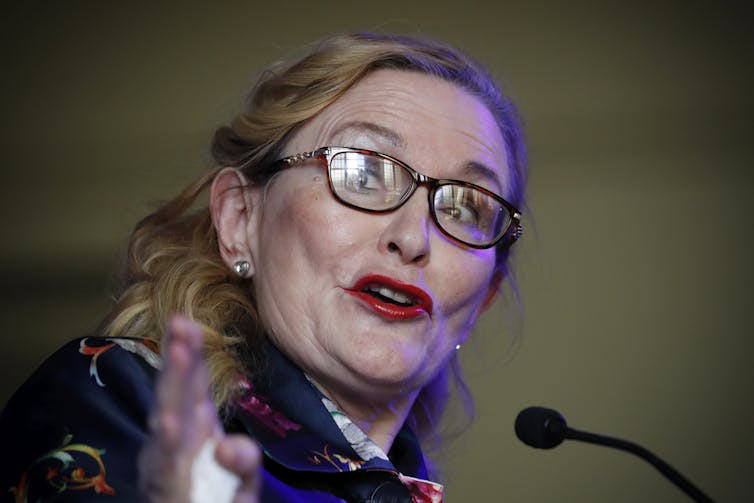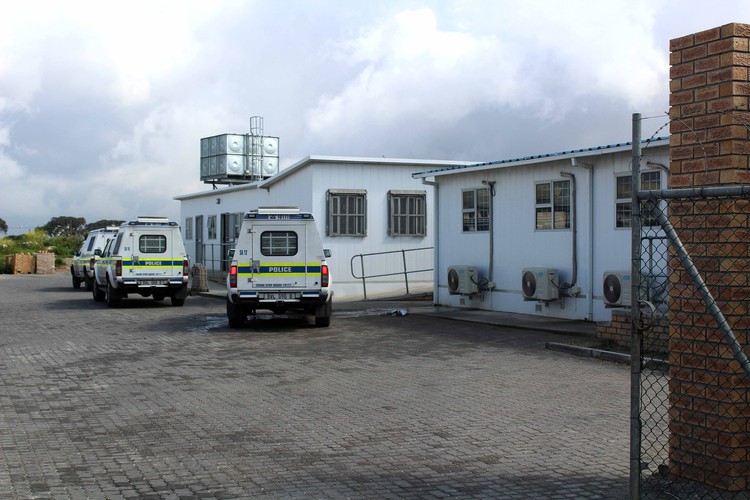
Helen Zille’s election as head of the Democratic Alliance’s federal council has rattled many.
EFE-EPA/Nic Bothma
South Africa’s main opposition party, the Democratic Alliance, elected a new chairperson of its federal council this past weekend. Its choice – Helen Zille, former leader of the party, and former Premier of the Western Cape province – has sent shock waves through the party.
The immediate fallout from her reelection to the top DA post was the resignation of Herman Mashaba, the DA mayor of South Africa’s largest city, Johannesburg. He decried Zille’s win as signalling a takeover of the party by rightwing elements.
Mashaba’s resignation is puzzling. A self-made businessman as well as a former chairman of a rightwing think tank, the Free Market Foundation, his criticism of Zille seems misplaced. His views on economic issues are on the right of the political spectrum. And Mashaba sounds even more conservative than Zille on the issue of undocumented immigrants.
Zille was elected to the party’s top post because she remains popular among the DA’s membership base. She is also the last top DA leader with anti-apartheid struggle credentials dating back to the 1980s End Conscription Campaign and the veteran human rights organisation the Black Sash.
But she’s also a hugely controversial figure. The reasons for this stem from comments she has made on Twitter in recent years, including a series in which she defended the legacy of colonialism.
Her posts prompted stinging criticism from the DA’s national leader, Mmusi Maimane, as well as other black members of the party.
Zille’s appointment, Mashaba’s resignation and signs that there is a concerted campaign within certain quarters of the party to get rid of Maimane all point to a political party that’s in deep turmoil. This affects the DA’s strength as official opposition nationally.
Tensions in the DA
The DA can best be described, mostly, as a broad church of liberals. One point on its spectrum are what could be called “equal-opportunity liberals”. Mainly white liberals, this group tends to oppose affirmative action, arguing that it violates the principle that opportunities should be allocated on merit.
Another faction comprises “affirmative action or diversity liberals”. The group is mainly black and supports race-based affirmative action as a way of addressing the past injustices of apartheid.
These camps are divided – not entirely, but significantly – along colour lines.
Read more:
Liberalism in South Africa isn't only for white people -- or black people who want to be white
As well as policy, there are other dimensions to tensions within the party.
One is around the coalitions it established in three cities after elections in 2016 when neither the ANC nor the DA won sufficient support to run the councils.
In Nelson Mandela Bay the DA took over running the highly corrupt council by establishing a coalition with a much smaller party, the United Democratic Movement. The partnership was fraught and finally collapsed in 2018 amid a great deal of acrimony.
In the cities of Tshwane, home to the country’s capital Pretoria, and Johannesburg, the DA’s toehold on power has been even more fragile. The DA is in a tactical alliance in both councils with the Economic Freedom Fighters (EFF) – the third largest party in the country, which presents itself as politically radical and to the left of the DA and ANC.
The DA and EFF’s tactical alliance involves the EFF supporting the DA’s mayors on a vote-by-vote basis, or abstaining from voting.
This appears to limit the DA from completely instituting the clean governance which it has made the showcase of its rule.
Another dimension to the DA’s current situation is that the party has two centres of power. Zille, as the newly elected chair of the federal council, the party’s highest decision-making structure in between its federal congresses, holds arguably the most powerful post in the DA. Maimane, as leader of the party, will be bound by the policy and strategic choices of the federal council led by Zille.
What next
It would be strategic for Zille and Maimane to immediately and seriously negotiate the relationship between themselves and between their posts. It will also be strategic for Zille to let a professional public relations officer handle her Twitter account in future.
Part of leadership is about making tough choices. One of these will be: does the DA relinquish power in Nelson Mandela Bay, in Johannesburg and in Tshwane, rather than taint its brand as the clean-up party?
If it fails to make these hard decisions it risks sliding even further in the polls. The party secured only 20.8% of the national poll in elections earlier this year.
This result is no doubt what’s brought the present tensions to a head – and not only about the future of Maimane. Other failures that have been pointed out include the DA losing Afrikaner voters to the rightwing Freedom Front Plus (FF+).
In 15 months the party will be in full campaigning mode for the local government elections in 2021. It will therefore need to finalise its leadership posts, its candidates, and its policies in the intervening months.
As well as preventing Afrikaner voters from swinging back to the Freedom Front Plus, the DA also needs to strategise how it plans to win back black votes, and win more of them than ever before.
For example, it needs to spell out its alternative options to affirmative action and black economic empowerment. This debate often goes under the title of “race as a proxy for disadvantage” – mostly economic disadvantage.
All told, the 60-year-old DA faces an interesting and complex year ahead. As the party grows larger, the coalition of viewpoints within it must also grow. Maybe it could learn a few lessons from the governing African National Congress, which brings together nationalists, communists and the labour movement, among other persuasions, in a veritable broad church.
Keith Gottschalk, Political Scientist, University of the Western Cape
This article is republished from The Conversation under a Creative Commons license.




